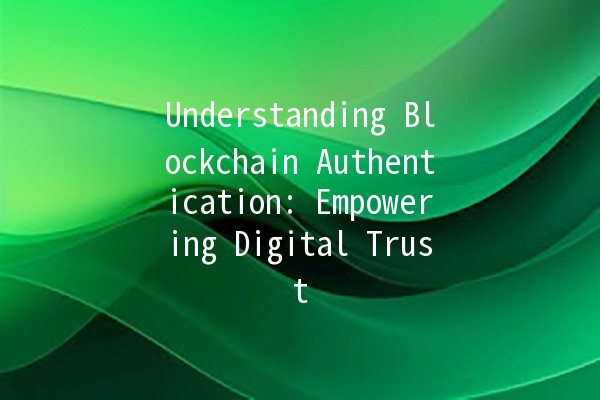




Blockchain authentication represents a transformative approach to verifying identities and transactions in a digital landscape characterized by increasing concern over data privacy and security. At its core, blockchain is a decentralized ledger technology that allows data to be stored securely across a network, making it nearly impossible to alter or tamper with the information once it has been entered. This feature is particularly advantageous for creating a trusted environment for various applications, including finance, healthcare, and supply chain management.
As organizations and individuals grapple with the task of establishing trust in digital interactions, blockchain authentication emerges as a critical component in enhancing security and streamlining processes. Here, we delve into the layers of how blockchain authentication works, its advantages, and practical productivity strategies to harness its potential effectively.

Overview:
Smart contracts are selfexecuting contracts with the terms of the agreement directly written into code. They automatically enforce and execute the terms when predetermined conditions are met.
Application Example:
For a property sale, a smart contract can be coded to transfer ownership automatically once payment is verified. This eliminates the need for intermediaries like real estate agents, speeds up the transaction, and reduces costs. By utilizing smart contracts, businesses can significantly enhance their operational efficiency and mitigate the risk of fraud.
Overview:
Decentralized identity (DID) solutions allow individuals to control their own digital identities via blockchain, reducing reliance on centralized authorities that often face data breaches.
Application Example:
In the healthcare sector, patients can possess control over their medical records stored on a blockchain. They can share these records with healthcare providers as necessary without exposing all their personal information, enhancing both privacy and security. The productivity gain here lies in simplifying patientprovider interactions and safeguarding sensitive information.
Overview:
Blockchain's immutable ledger facilitates transparency throughout the supply chain, ensuring the traceability of products from origin to destination.
Application Example:
A food production company can utilize blockchain to track the entire journey of its products. Each step — from harvesting to processing to distribution — is recorded in realtime. If a food safety issue arises, the company can pinpoint the source quickly and efficiently, ensuring faster response times and compliance with safety regulations.
Overview:
Digital signatures utilize blockchain technology to create a tamperproof validation of documents and transactions, confirming authenticity and preventing unauthorized changes.
Application Example:
Legal documents such as contracts can be signed digitally and stored on a blockchain. This method eradicates the hassle of physical signatures and waste associated with item dispatch. Additionally, the authenticity of documents can be verified instantly, saving time and reducing the potential for disputes.
Overview:
Blockchain technology significantly reduces the time and costs associated with international transactions by devolving the conventional banking processes.
Application Example:
A business operating internationally can use blockchain for its remittances, bypassing traditional banking fees and delays. By using cryptocurrencies or stablecoins on the blockchain, instant transfers can occur with lower rates than conventional banks and payment services, improving cash flow.
As blockchain technology continues to evolve, its potential for authentication expands, promising a future where digital interactions become more secure, efficient, and usercentric. Industries ranging from banking to elections are exploring how to best integrate blockchain authentication to safeguard user data while enhancing their services.
The adaptability of blockchain authentication indicates that organizations need to be forwardthinking in their approach to technology adoption. Companies that embrace these innovations may find themselves at a significant competitive advantage, offering improved customer trust, enhanced privacy measures, and streamlined operations.
Blockchain authentication refers to the use of blockchain technology to verify the identities of users, transactions, or data entries. This process is decentralized and relies on cryptography to ensure integrity, thus enhancing trust in digital interactions.
Traditional authentication methods often rely on a central authority, which presents a single point of failure. Blockchain, by being decentralized, diminishes this risk. Once data is recorded on a blockchain, altering it is virtually impossible, making it more secure against hacks and unauthorized changes.
While blockchain authentication has significant potential across many sectors, its impact is particularly pronounced in areas requiring highsecurity measures, including finance, healthcare, and supply chain management. Each industry must evaluate its unique needs and regulatory compliance.
The initial implementation of blockchain authentication may require a significant investment in technology and training. However, over time, the reduction in fraud, errors, and operational inefficiencies can lead to substantial savings, making it a costeffective solution in the long run.
Potential challenges include scalability issues, regulatory uncertainty, and the need for widespread user acceptance. Organizations must navigate through these hurdles to achieve successful implementation.
Individuals can start by learning about blockchain technology and exploring platforms offering blockchain services. Participating in forums, attending workshops, and using userfriendly blockchain applications can also enhance their understanding and practical experience.
The exploration of blockchain authentication reveals a world of possibilities for enhancing trust and efficiency in digital interactions. As organizations leverage these technologies, they pave the way for a more secure future in various industries.
This article covers the innovative aspects of blockchain authentication while diverging into practical techniques to enhance productivity. The structure facilitates ease of reading, ensuring key points are digestible for a diverse audience, ultimately aligning with SEO best practices.